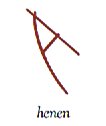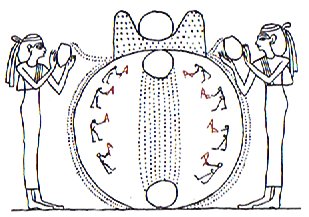At Rigel (*78) were sweet long roots of ti
and at *79 were bitter little kape seedlings:
... (There were) five hundred baskets of banana
shoots, a thousand baskets of taro, fifty bundles of
long ti roots, and ten baskets of little kape
seedlings. [500 + 1000 + 50 + 10 = 26 * 60.] They
tied up the baskets carefully, and Oti said to his
assistants, 'Take all the baskets [ka mau tahi te
taropa] on board the canoe [ki runga ki te
miro], as well as [tokoa] the hundreds of
[?] ti roots!' The men picked up the baskets and
brought them on board the canoe. They arrived and
left them there [he tuu he hakarere] ...
[E:68-69]
|
10
variants of taro brought by Oti from the
plantation of
Teke: |
|
1 |
ngeti uri. |
a Teke. a Oti. |
|
2 |
ngeti tea. |
|
3 |
he ngaatu. |
|
4 |
he tuitui koviro. |
|
5 |
he ketu anga mea. |
|
6 |
he ketu takarua. |
|
7 |
he
teatea. |
|
8 |
he ngu haha tea. |
|
9 |
he mango. |
|
10 |
he hahara rapanui |
|
1 |
he
ti. |
|
1 |
he
kape. |
|
8
he ngu haha tea. |
9
he mango. |
10
he
hahara rapanui
1 he ti. |
1
he kape. |
The 9th taro variant he
mango. was presumably a verbal sign
corresponding to the glyph type Metoro
helped me label mago - a sign of the
'tail' (the end):
 |
180 |
 |
|
5 |
186 |
|
vaha mea |
mago |
|
182 days |
Hara. Harahara 1.
Misaligned (of roofing, basketware, etc.);
e harahara nó te kete, the basket is
misaligned (its strips are not parallel. 2.
A sort of taro. 3. Latrine, defecating
ground. Vanaga. 1. Pandanus. P Mgv.: ara,
puhara, pandanus (tree); hara,
a bunch of pandanus fruit, old pandanus.
Mq.: faá haá, pandanus. Ta.: fara,
id. 2. Error, mistake, oversight, wrong; to
err, to confound, to mistake; manau hara,
illusion; toua hara, discussion
without knowing the object. P Mgv.: ara,
arara, defective, abortive, to miss,
to fail, a fault, a quarrel; hara, a
fault, a mistake, an error, a dispute, a
quarrel, undisciplined. Mq.: hara, a
rake, libertine. Ta.: hara, sin,
fault, crime. Churchill.
Ti by lying with Tattooing made the
ti plant (he ti ki ai ki roto ki a
he ta ka pu te ti). Burnt ti
leaves were used to produce the black dye
for tattooing.

Kape. 'Bitter-taro' (Alocasia
macrorrhiza). In 1957 kape
was still cultivated in much the same
way as dry taro. It is a type of food to
be eaten during times of famine.
According to Fuentes (1960:856), the
tubers had to be kept in the earth-oven
for 15 (sic) days in order to
eliminate some of the poisonous
components. Barthel 2. Arum, yam.
Churchill. Bitterness by doing it with
Bad-taste produced the kape (mangeongeo
ki ai ki roto he rakerake ka pu te kape).
|
|
APRIL 1
(91) |
2 |
3 (*13) |
4 |
5 |
 |
 |
 |
 |
 |
|
Ga1-11 |
Ga1-12 |
Ga1-13 |
Ga1-14 |
Ga1-15 |
|
HAEDUS II
= η Aurigae
(75.9) |
5h (76.1)
ε
Leporis (76.0),
CURSA
=
β
Eridani
(76.4),
λ
Eridani (76.7)
*35.0 = *76.4 - *41.4 |
μ Aurigae, μ Leporis (77.6) |
ĸ Leporis (78.0),
RIGEL
(Foot) =
β
Orionis
(78.1),
Flaming Star = IC405
(78.2),
CAPELLA
=
α
Aurigae
(78.4),
ο
Columbae,
τ
Orionis (78.8)
*37.0 = *78.4 - *41.4
THUBAN (α Draconis)
|
λ Aurigae (79.0), λ Leporis (79.6), ρ
Aurigae (79.7)
ARCTURUS (α Bootis) |
 |
|
June 4 |
5 |
6 (157
= 314 / 2) |
7 (94 + 64) |
8 (*444) |
|
°May 31 (151) |
°June 1 |
2 (*73) |
3 (94 + 60) |
4 (*440) |
|
'May 8
(128) |
9 |
10 (*50) |
11 (94 + 37) |
12 (*52) |
|
"April 24
(114) |
Vaitu Nui 25 (*35) |
26 (4 * 29) |
27 (94 + 23) |
28 (118 = 4 * 29) |
|
... The
Explorers had left their old homeland in
"April 25 (115) - implying the synodic cycle
of Mercury - and they
had returned half a year
later, in "October 25 (298 = 115 + 183),
which was 10 days after the arrival of the
Royal Double Canoe ... |
Also ti and kape were variants of taro.
... Ta'aroa tahi
tumu, 'Ta'aroa origl. stock' - most commonly
Ta'aroa or Te Tumu - existed before everything except
of a rock (Te Papa) which he compressed and begat a
daughter (Ahuone) that is Vegetable Mole.
Ahuone means 'earth heaped up'
- a widespread name for the Polynesian first woman. It sounds as
if Cook also heard the term applied to the banks of humus and
rotting material on which taro is grown. In the English
of his day this was known as 'vegetable mould'
...
... the Hawaiian staple, taro, is the
older brother of mankind, as indeed all useful plants and
animals are immanent forms of the divine ancestors - so many
kino lau or 'myriad bodies' of the gods. Moreover, to make
root crops accessible to man by cooking is precisely to destroy
what is divine in them: their autonomous power, in the raw
state, to reproduce ...
Counting from Te Takapau (Sirrah, The
Navel of the Horse) there were 79 (→ spring equinox) variants of
roots. And for these, of course, a digging stick had to be used.

Then sweet droplets of water had to be applied.
... Poi is a
Hawaiian word for the primary Polynesian staple food made from
the corm of the kalo plant (known widely as taro). Poi
is produced by mashing the cooked corm (baked or steamed) to a
highly viscous fluid. Water is added during mashing and again
just before eating, to achieve a desired consistency, which can
range from liquid to dough-like (poi can be known as
two-finger or three-finger, alluding to how many fingers you
would have to use to eat it, depending on its consistency).

|





